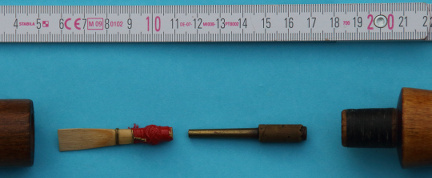
Renaissance soprano shawm,
modified with windcap
300 dpi JPEG

Hier geht's zur deutschsprachigen Version
Go here to the German version
 Renaissance soprano shawm, modified with windcap 300 dpi JPEG |
Shawm |  Hier geht's zur deutschsprachigen Version Go here to the German version |
In general "shawm" is a term for a whole family of instruments. Mostly known are shawm, bombard, rauschpfeiff,
oboe, bombarde, zurna and shenai. Shawm instruments are also called oboe instruments in western influenced organology, although (modern) oboe is the most atypical member of shawm family. Shawms are double-reed wood-wind instruments with a conically bored tube that's mostly finished with a large
bell. Shawms have 7-8 medium sized fingerholes whereby eight hole is fingered with left thumb.
Cross fingerings can be used. Lowest tone often is handled by a key on large instruments. Modern bombarde is available as a fully
cromatic instrument with fingerholes and keys. Modern oboe is fully equipped with keys. All instruments sounds rather loud except
oboe. All instruments have a large range to slide tones. Shawms overblow at first times into the octave, at second times
into the twelfth. Mostly they are only overblown once.
In the era of the Renaissance shawms, rauschpfeiffs and bombards were build in different sizes. Instruments in c/f-pitch are mostly used for ensemble playing today. Shawms and rauschpfeiffs are build in sizes sopranino (lowest tone f¹), soprano (lowest tone c¹), alto (lowest tone f⁰) and tenor (lowest tone c⁰) and rarely garklein (lowest tone c²) too. Fingering on tenor instruments is very problematic caused by large distances between fingerholes. Therefore larger instruments aren't build. More recently rauschpfeiffs in d/g-pitch are build for an easier playing together with the Marktsackpfeife. Bombards are build in sizes soprano (lowest tone c¹), alto (lowest tone f⁰), tenor (lowest tone c⁰) and bass (lowest tone F). Lowest tones are handled with keys on larger instruments. A great bass instrument (lowest tone C) hasn't come to stay because it's very unwieldy and requires a high air flow.
Three techniques exist to blow instruments of the shawm family:

The instrument shown above is a modified soprano Renaissance shawm. Originally the instrument had no fingerhole for left thumb. This was bored later. This thumb hole enables to play faster and more easily in non overblowing range (tones c¹d¹–d²). The pirouette was lost. A holder for the windcap was mounted on holder for the pirouette. Windcap and whose holder are made of beechwood and are stained and waxed. The instrument has a scale range of c¹d¹–c³ and is tuned up to tuning pitch a¹ = 440 Hz. Complete scale range is available if this instrument is played with windcap. Windcap increases "life" of double-reed extremely. ☺
Term "shawm" has some other meanings too:
shawm (1): family of instruments (see above)
shawm (2): instrument (see above)
shawm (3): general term for all reed instruments
shawm (4): chanter of a bagpipe. This meaning confuses a little bit and can only be understood by means of term shawm (3).
shawm (5): organ stop, usually 8′ or 4′. This reed stop has either gentle conical or cylindrical resonators. If cylindrical resonators are used they are finished with a large conical bell. If gentle conical resonators are used, they can be finished with a large conical bell too. This stop is to be imitated sound of the Renaissance shawm.
shawm (6): popular name for Martin's trumpet. This instrument was developed at beginning of the 20. century and has nothing to do with shawm (2).
Bagpipe |
Rauschpfeiff |
Top |
Main page |
© Sönke Kraft, Hannover 2001 last update: 11.09.2023 |